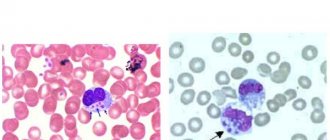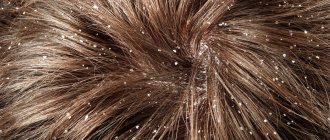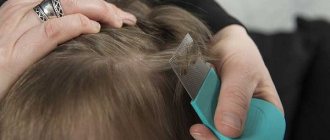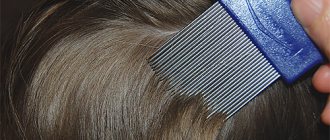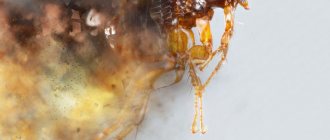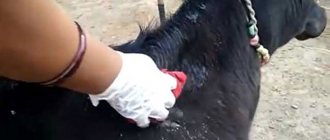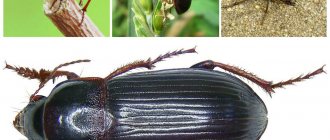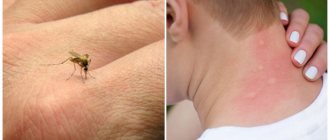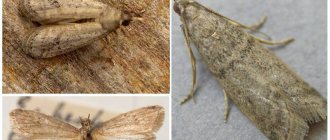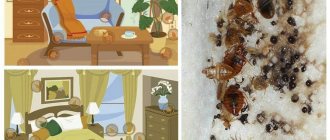Features of pubic lice
These are small insects - up to 3 mm. Females are noticeably larger than males. They have a flattened oval body that is light brown in color. Three pairs of legs are spread wide, so it seems that the width of the insect is greater than its length. The legs are long and pincer-shaped. The structure allows them to move along triangular hair. They cannot attach to the round hairs that grow on the head, so they do not live on the head.
Like other types of lice, pubic lice go through several stages of development:
- nits – white eggs, inside of which larvae develop; this stage takes up to a week;
- nymphs of stages 1, 2 and 3 – in 15–17 days the parasite goes through three moults and becomes sexually mature;
- adults.
Read more in the article “Incubation period of lice and nits”
Pubic louse lives up to 30 days. During its life it lays about 50 eggs.
Without food, the parasite lives for a day. If unfavorable conditions occur, the pubic louse can fall into a state of suspended animation and spend several months in it. Pubic lice can survive up to two days in water. They can withstand loads of up to 1 kg. For example, on the beach, in the sand, they can exist for several days.
Where can you find pubic lice?
As mentioned above, pubic lice live on the hairy parts of the human body, but do not affect all the hair. They are attracted to areas with apocrine glands that secrete a special secretion:
- pubis;
- crotch;
- anus;
- scrotum;
- armpits.
The affected areas are always covered with hair. These parasites do not live on smooth skin. The disease occurs in both men and women. Children can also become infected with it if they have hair on their genitals.
How can you become infected with phthiriasis?
There are several ways the disease can spread. The most susceptible to this are women and men who lead an antisocial lifestyle and promiscuous sex life, as well as those who do not maintain personal hygiene.
But you can also catch pubic lice through:
- clothes of a sick person;
- towels and bed linen;
- public toilets;
- beaches, solariums;
- baths, saunas, swimming pools, etc.
Even with careful hygiene, no one is protected from infection, so it is important to be careful when visiting public places and communicating with potential carriers of parasites.
Symptoms of phthiriasis
Pubic lice can be seen without the use of special equipment. They are small, but move quite quickly. Nits are very small and are attached at the very base of the hairs, so they can be very difficult to notice.
In addition to a visual examination, you can find out about the presence of phthiriasis by the following symptoms:
- constant itching - it occurs due to the fact that when bitten, the parasite injects a substance under the skin that is an active irritant;
- small blue dots at the bite sites are traces of an injected substance that prevents blood clotting;
- Due to unbearable itching, a person scratches the skin, skin damage appears, including dermatitis and eczema.
When affected by phthiriasis, a person becomes restless and irritable.
Sometimes symptoms appear even with a small number of parasites on the body. They may not be seen due to the fact that they are hidden in matted and thick curls of hair. In this case, you should consult a doctor to confirm the diagnosis. The specialist uses the following methods for detecting parasites:
- examination with a Wood's lamp - it allows you to see live nits, which in its fluorescent light look white, and dead ones remain gray;
- examination of the affected areas at multiple magnification using a videodermatoscope;
- Examination of the eyes with a slit lamp to detect nits on the eyelashes.
Symptoms of the disease
The disease can be identified by characteristic signs:
- Severe itching that occurs in the pubic area, as well as in the perineum. This condition is caused by insect bites, which irritate the skin and force a person to constantly scratch the area.
- The formation of spots of a characteristic blue color where the bites were made. The size can reach 1 cm. Upon visual inspection, points from the bite site can be traced in the middle of the bruises. The spots disappear within a few weeks.
- Allergic rash.
- Presence of nits.
- Slight dizziness.
- Nauseous condition.
- Weakness and loss of appetite.
It is important that in the presence of an advanced stage of pubic lice, the lymph nodes may become enlarged and the skin may feel rough and thick to the touch. Scar formation is possible in areas where the scratching occurs.
Why is phthiriasis dangerous?
Skin damaged by scratching is favorable conditions for infections to enter the body. The scratched areas become infected, ulcers and boils appear on them. If left untreated, the infection goes deeper into the lymph system. This can lead to systemic diseases and blood poisoning. Pubic lice, with their saliva, transmit infectious diseases, such as typhoid, from person to person.
Many patients experience allergic reactions. Also, phthiriasis is almost always accompanied by sexually transmitted diseases. It could be chlamydia, gonorrhea, syphilis. Pubic lice, passing from person to person, carry the causative agents of these diseases in their saliva. This is precisely what causes the most danger of infection with lice pubis.
When a person is very seriously affected and there are a large number of lice, they do not have enough space to live in the groin and armpits. In this case, they can live on eyebrows and eyelashes. When these areas are affected, conjunctivitis, blepharitis and other eye diseases develop.
Diagnosis of the disease
A doctor can diagnose lice pubis after a thorough examination and questioning of the patient, and also by identifying nits and adult lice.
The inspection is carried out using a magnifying glass or magnifying glass.
Videodermatoscopy is considered the most accurate diagnostic method. The examination is carried out using a digital video camera with video capture and light polarization functions. When you connect the camera to a computer monitor, the image is displayed on the screen.
The camera allows you to take pictures of the affected area, which are then carefully examined by the doctor at multiple magnifications. This method allows you to detect the presence of live insects and nits.
Observation is carried out in this way throughout the entire course of treatment. This is necessary to identify dead and living individuals. The former do not contain eggs, so their detection is the basis for refusing to continue further treatment procedures.
- Development of allergies to secretions secreted by insects.
- Damaged areas of the skin increase the risk of infectious diseases.
- Pustular infections.
- The appearance of boils and abscesses.
- Sepsis.
- Tearing.
- Trichiasis.
Ways to combat pubic lice
Getting rid of pubic lice is much easier than getting rid of head or body lice. The most effective way is mechanical. That is, you just need to remove all hair from the affected area so that parasites do not have the opportunity to live on the body. They cannot move on smooth skin. The “fashion” for hair removal in intimate areas over the past few years has significantly reduced the incidence of this disease.
If you are infested with pubic lice, you need to shave or otherwise remove the hair on the infected area. It is better to remove hair from the entire body so as not to leave any opportunity for parasites to survive unfavorable conditions nearby. After hair removal, it is advisable to apply pediculicide to the affected area to destroy nits, which, due to their small size, can be hidden in the skin flakes.
If for some reason it is impossible to use the mechanical method, then you can use folk remedies or special preparations that kill lice and nits.
Treatment
There are two ways to get rid of parasites. The first is radical and involves complete hair removal. It's fast and efficient. But this option is not suitable for all people and depends on the location of the parasite. After all, you hardly want to say goodbye to eyebrows or a beard, which are so difficult to grow. Therefore, chemists have developed special preparations to treat pubic lice.
Chemicals should be used only after consultation with a specialist . The remedy for pubic lice can cause allergies and local irritation, so its use must be used with caution.
For convenience and effective control, many insecticidal preparations have been created. Different shapes offer different possibilities for use. Choosing a convenient option is not difficult. Ointment, cream, solution or aerosol are highly effective.
The composition contains a special ingredient that has a detrimental effect on parasites. The substance penetrates the chitinous membrane and disrupts the conduction of nerve impulses. The pubic louse dies from paralysis. Some drugs can block the parasite's air supply and the insect dies from suffocation.
Sprays
Treatment of lice pubis is successful when using products that have pyrethrum as an active ingredient.
Spray Pax
At a concentration of 25% it is contained in the aerosol preparation Spray Pax.
Shake the bottle and spray it onto the pubic and perineal hair with short presses. After 30 minutes of treatment, wash off Spray Pax with soap. The effect is achieved the first time. Adult insects and nits die.
Spray Paranit
Contains natural ingredients. According to the manufacturer, the drug is effective against lice and nits.
Spray onto the scalp and leave for 15 minutes. Afterwards wash well with soap. Repeated treatment is carried out after a week.
Solutions
Successful treatment for pubic lice is carried out with liquid preparations, which must be applied to the hair of the pubis and perineum and rubbed into the skin.
Nittifor
The drug contains permethrin. It destroys the membrane of the nerve cell, thereby stopping the normal functioning of a living organism.
The pubic louse dies from paralysis. The pubic hair is moistened with the liquid and washed off with water after half an hour. After 7 days, repeat the procedure.
Shampoos
Veda-2
A small amount of Veda-2 is foamed on damp hair.
Wait 10 minutes and wash off. After a week, repeat the procedure.
Shampoo Peddelin
The shampoo is distributed over the hair and rubbed into the skin.
A ten-minute treatment will destroy adult parasites and nits. Repeat treatment after a week.
Emulsion
Medifox
Prepare a solution by mixing 4 ml of Medifox emulsion (5%) and 100 ml of water.
Wet pubic hair and moisturize the skin. After 20 minutes, wash off. Repeated treatment is carried out after a week.
Soap
Antiparasitic agent based on permethrin.
Effective against pubic lice and their nits. Lather on hair and leave for 20 minutes.
Ointment
This group is represented by several means:
Nittifor, Benzyl benzoate, Nix. Boric, sulfur-mercury ointment for pubic lice destroys parasites and nits. Rub the insecticidal agent into the skin for several days (3-4) in a row, then take a break for several days and repeat the treatment. Before each application, a hygienic procedure is carried out.
Folk remedies
These are the same products that are used to kill hair or body lice and nits. The affected areas are lubricated with the following means:
- vinegar solution;
- pulp of crushed cranberries;
- Castor oil;
- geranium oil
All these options are quite gentle. They do not cause harm to health, but require long-term use for the effect to occur. If they are severely infested with pubic lice, they are powerless. In addition, you will have to leave the product on the affected areas for some time to work. This is not always convenient or appropriate.
More aggressive options can be used:
- 3% hydrogen peroxide;
- boric or sulfur ointments;
- kerosene.
They must be used with great caution, as these products may be toxic or cause burns to the mucous membranes. In addition, they may not be effective against nits.
Professional products
Phthiriasis should be treated with medication using effective agents that work against lice and nits. These are pediculicides that kill parasites. You can use drugs based on different active ingredients: Medilis-Permifen, Medilis-Bio, Medilis-Malathion or Medilis-Super. They are available in the form of a spray or emulsions. Each drug is accompanied by instructions for use, which must be strictly followed. Most drugs can be used by people who do not have individual intolerance. Some can be used to treat children from 5 years of age. The result will come within a few minutes or hours.
How to treat the disease
To treat the disease, many different drugs and products have been developed: shampoos, ointments, solutions and sprays.
In most cases, they use Medifox, on the basis of which the solution is prepared, and also the Spray-Pax aerosol. These drugs are contraindicated for use during pregnancy and lactation. During this period, it is better to resort to sulfur ointment 33%.
Pedilin shampoo is prescribed for the treatment of both pubic and head lice. Apply the product to the groin area; it is recommended to foam it first. The annotation indicates the exact time that you need to keep the drug on the skin. After the procedure, rinse well and then comb out with an insect comb.
What must be done when treating phthiriasis
Pubic lice can hide not only on a person’s body, but also in his personal belongings. Therefore, during treatment, it is important to treat underwear, clothing, bedding, and towels. It is better to soak all items that can be washed in a pediculicide solution and wash at high temperature, and after drying, carefully iron or treat with a steam generator. Closets where clothes and linen are stored should be washed with a pediculicide solution. It is advisable to treat mattresses and upholstered furniture with a steam cleaner. Since lice can wait out unfavorable times in a state of suspended animation, it is necessary to do a general cleaning and wash all surfaces with an insecticide solution. This will remove insects from the home that could survive the treatment and then return to the human body.
Prevention
Pubic lice can affect anyone, regardless of their lifestyle. To reduce the likelihood of illness, you should take the following measures:
- carefully observe personal hygiene;
- do not engage in sexual contact with strangers;
- do not use other people's bed linen;
- do not wear other people's clothes and underwear;
- do not use other people's towels.
In public places, you should protect yourself as much as possible from lice. For example, you should not sit on the seats in the sauna or in the changing room of the swimming pool without a personal sheet or bedding.
After visiting a place where infection is possible, you must thoroughly wash, wash and iron your clothes with a hot iron. For prevention purposes, it is worth removing hair in intimate areas.
If you suspect a pubic lice infestation, you should consult a doctor and begin treatment, preventing the insect population from increasing many times over. If you start fighting right away, you can get rid of them quickly and without health consequences.
Preventive actions
After the course of treatment you should:
- undergo regular medical examinations;
- observe the rules of personal hygiene;
- disinfect linen, bedding and clothing of both the patient and his sexual partner;
- give up promiscuous sex life.
Remember that consultation with a doctor is necessary in all of the above cases of lice detection.
An experienced doctor will prescribe the safest drug for treatment and give the correct recommendations for eliminating head lice.
The sooner the problem is identified, the easier it is to get rid of blood-sucking parasites. Be healthy!
Drugs that act on pubic lice.
Pubic lice are small ectoparasites that live, grow and reproduce on the human genitals. The presence of parasites does not threaten human life and health in any way, however, ectoparasite bites lead to allergic reactions. Wounds appear, which are an ideal place for bacterial infections to grow and develop. Let's look at what control methods and medications exist against pubic lice.
Phthiriasis is a disease caused by a pubic parasite. The disease causes damage to the hair in the intimate area. However, louse can also settle in the armpits, eyebrows and eyelashes. The only place where the flathead cannot live is the head, since round hair is inaccessible to the parasite.
The pubic parasite is characterized by a normal structure and color: the body color is light gray, so it is difficult to notice the parasite on the human body. The louse does not move, it grows into the skin and feeds on human blood in one place.
One parasite can lay more than a dozen eggs per day. In just a month, the entire human hairline will be affected by the parasite.
If a person is infected with ectoparasite eggs, the first symptoms will appear a month after the invasion. If a person becomes infected with an adult, clinical manifestations appear immediately.
